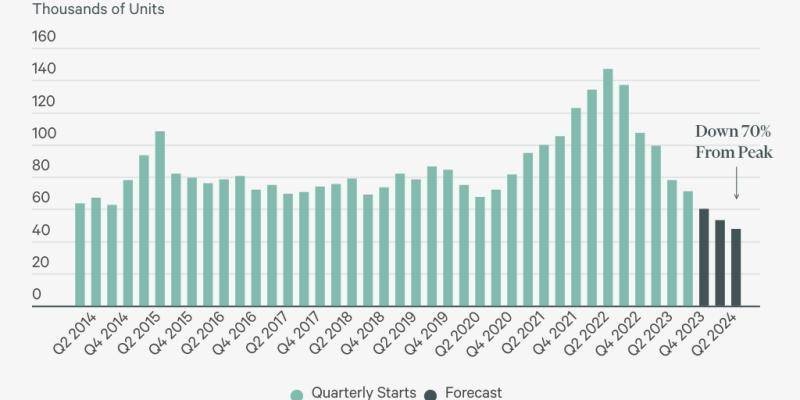In case you missed it, Scott Trench, CEO of BiggerPockets, wrote this thoughtful article: Multifamily Is at High Risk of Continuing Its Historic Crash in 2024—Here’s Why. Scott and I have been discussing this topic offline anyway, so I thought I would take him up on his invitation to debate the subject online. Healthy debate is what BiggerPockets is all about, right?
I will start by saying I agree with most of what Scott wrote. I agree with most of his facts, the challenges facing the multifamily space, and especially the problems with many operators who have run into problems of late.
However, I disagree with Scott’s conclusion. I think now is a great time to save up your dry powder and pick up properties that may be financially distressed but are otherwise well-located, excellent assets taken over by proven operators.
I will argue that the multifamily asset class as a whole is fundamentally sound despite some short-term supply issues. Patient investors who wait for the right deals will be rewarded.
The distress in multifamily is not a tidal wave—it’s more like a trickle. But rest assured, it has already started, and there are deals to be had at valuations we haven’t seen in many years.
As in any market cycle, the time to hunt for great opportunities is not when all is well, euphoria is high, and everyone is chasing the same deals. When asset prices get frothy, it is exactly the time to hit the pause button. And when blood is in the water, it is exactly the right time to go shopping.
But I defer to the two best investors of all time, Warren Buffett and his recently deceased partner, Charlie Munger—the Batman and Robin of investing:
“Be fearful when others are greedy, and greedy when others are fearful.” – Warren Buffett
“The best thing that happens to us is when a great company gets into temporary trouble… We want to buy them when they’re on the operating table.” – Charlie Munger
That said, no one wants to catch a falling knife, which is where careful analysis and patience are critical.
I will offer my perspective on “what good looks like” later. For now, let’s dive in and unpack Scott’s core thesis.
Scott Says: “It Just Doesn’t Make Sense to Buy Apartment Complexes at Current Valuations”
Scott’s arguments:
- Average cap rates for multifamily are too low (5.06%), making this asset class too expensive. Their sole purpose is cash flow, and they aren’t doing a good enough job producing it.
- Right now, interest rates are generally higher than cap rates (negative leverage), making it hard to make money.
- There are better, lower-risk ways to generate 5% cash returns (Treasuries, commercial debt, etc.).
- There’s more room for multifamily valuations to fall (even more than the current 30% from peak).
My response: Yes, but a deal is a deal. And there are some good ones.
Scott makes a compelling argument that average apartment valuations are out of whack with the new reality of higher interest rates and that there are better ways of making a 5% return in today’s market.
My simple answer is: Don’t invest in those deals. You can do much better. If I’m not confident I can make a 15% to 20% annual return (cash flow plus appreciation) on a multifamily deal, I am not interested.
The issue is that, even though apartment valuations on paper have come down (20% to 30%-ish), there isn’t enough transaction volume yet to reflect the new reality. So, while there are deals that are still trading at 5% cap rates, for example, many more deals are not being traded at all because most sellers are in denial and would prefer to wait it out.
That said, I am seeing quality assets being bought at 6.5% and 6.8% cap rates, with interest rates at 5% and below. At some point, sellers won’t be able to hold on any longer, and more of these better deals will be available.
The best apartment acquirers didn’t acquire many properties at all in 2023 for this exact reason. Investors need to be patient, just like these seasoned operators are.
The bigger point is that we, as investors, don’t buy averages. We buy specific properties in specific markets. “Average” cap rates for single-family homes are terrible right now as well because prices and interest rates are high.
Don’t buy those deals, either. Don’t buy with negative leverage, don’t buy without cash flow, and don’t buy at inflated prices. Find better deals.
How far will multifamily values drop from their peak? My honest answer is, I don’t know. It’s hard to time the bottom.
I do know that buying now, at a 30% discount, is better than buying at the top. All else being equal, a 6.5% cap rate is better than a 5% one. If you are buying a good deal with a solid operator and hold it over a long enough period, you have a recipe for success.
Most importantly, the fundamentals of the apartment asset class are strong. And that creates a floor for future valuation declines and prevents an apartment-pocalypse. More on that next.
Scott Says: “The Outlook for Rent Growth Is Poor in 2024”
Scott’s arguments:
- A record supply of new multifamily units will be delivered in 2024, which will push down rent prices.
- Markets like Texas, Florida, North Carolina, Denver, and Phoenix are at high risk due to excessive supply.
- Higher rates may drive more people to rent, but they also reduce demand as homeowners with low interest rates stay put.
- Renters prefer single-family homes.
- The combination of too much inventory and insufficient population and income growth could hurt apartment owners.
My response: Agreed, but just wait. Plus, demand is strong.
Scott is 100% correct about the influx of new apartment supply hitting the market in 2024. This will cause rents to stagnate in 2024, and in some markets, rent may even decline. Some markets will get hit harder than others, as Scott points out. This is a mathematical certainty.
But we, as real estate investors, should have a much longer time horizon than one year. What happens in 2025 and beyond? That’s when things get more bullish.
Take a look at this chart from CBRE’s “2024 Outlook Summary: Historical & Forecast Multifamily Construction Starts.” You can see that the huge spike of new projects that started during the pandemic is being delivered now.
But then look what happened. Starting in 2022, new projects tanked due to high interest rates and construction costs. That means new deliveries will decrease dramatically in 2025-2026. Supply/demand should rebalance, and rent growth should accelerate again.

2024 renters should get a badly needed break from incessant rent spikes. I think that’s a good thing for society. This also supports my thesis: The lack of short-term rent growth will put more pressure on those apartment owners who are already struggling with high interest rates.
The result for investors: More opportunity to pick up discounted properties. Smart investors with a long-term perspective will see over the horizon and past the short-term choppiness.
However, what about the demand side of the equation? CBRE forecasts that although vacancy rates will continue to surpass their pre-pandemic averages in 2024, sufficient demand will maintain the average occupancy rate above 94%. Developers have accurately gauged where demand will most effectively support new supply.
The markets with the most extensive supply pipelines (such as Dallas, Austin, Nashville, and Atlanta) boast the highest job growth projections. So it’s not so much the new supply but the absorption rate that matters the most—and the new supply should be absorbed over time.
Record unaffordability for home purchases also bolsters demand for renting. Scott points out the other side of this—that homeowners with low interest rates aren’t moving—which reduces rental demand as well. But the vast majority of these locked-in homeowners would be much more likely to buy than rent anyway.
The big picture here is that the U.S. suffers from a huge undersupply of housing, and that fact ensures strong demand for all residential real estate: single-family, multifamily, affordable housing, etc. The current influx of supply won’t make much of a dent. A significant softening of employment could change that, but otherwise, the long-term supply/demand equation favors apartments.
But as always, real estate needs to be analyzed at the local level. Investors should always evaluate the supply-demand dynamic in their local market and submarket.
How quickly is new supply being absorbed in your local market? What new projects might be coming onboard near your target property that could cause issues? These are great questions to ask the deal sponsor and require supporting data.
Scott Says: “Expenses Eat into Multifamily Profit”
Scott’s arguments:
- Property taxes and insurance costs are surging, with an average 19% increase in 2023.
- Insurance premiums have spiked by 100% to 200% in parts of the South and West.
- These cost hikes are uncontrollable and directly impact property valuations.
- Rising labor costs are squeezing multifamily operators’ bottom lines.
My response: OK, Scott wins this round.
Touché. Scott wins this one. Increases in property taxes and insurance are a leech on the bottom line of apartment owners, and there’s no good remedy in sight.
One would think that property taxes would fall in line with falling property values. But like Scott, I am skeptical. And insurance costs are ridiculous.
A couple of points to remember, though. First, all these same factors hurt the economics of single-family rentals just as much. For example, I’m selling my SFRs in Texas because property tax spikes alone turned my once-profitable gems into a negative cash flow money pit.
Second, make sure operators are appropriately accounting for these costs in their projections—baked into the cake if you will.
Finally, there are some niche strategies that address the property tax issue. A tactic some operators use is negotiating with local tax authorities to completely eliminate property taxes in exchange for dedicating some units to affordable housing. It’s one of my favorite strategies in high property tax markets like Texas.
Scott Says: “Interest Rates Won’t Come to the Rescue”
Scott’s arguments:
- The Fed is likely to cut the federal funds rate by 75 basis points, but no one knows what impact that will have exactly.
- Normally, cuts will also lower the 10-year Treasury, which in turn should lower borrowing costs.
- But currently, the yield curve is inverted—meaning short-term rates are normally lower than the 10-year Treasury, but right now, they are higher.
- If the yield curve normalizes, then even a Fed rate cut won’t prevent a higher 10-year Treasury rate (~6%, for example).
- Expecting the 10-year Treasury to decrease is risky. It’s safer to assume it will rise, which would lower apartment valuations.
Response: True. But a good deal works regardless of interest rates.
Scott is clearly a big interest rate nerd! Inverted yield curve prognostications aside, let me try to translate for the rest of us.
Most people think apartment borrowing costs will go down, which would give apartment owners stuck with high variable rates some relief. Scott is the contrarian: He thinks borrowing costs could go up even if the Fed lowers rates.
What do I think rates will do? I have no idea! The biggest mistake apartment operators made over the last two to three years was assuming rates would stay low when they refinanced their bridge loans. They bet wrong, and they are now getting crushed. If borrowing costs do rise, that creates more stress and, therefore, more deals for the savvy investor to pick up.
But more importantly, your investment strategy needs to be interest rate-agnostic. In other words, it needs to work if rates go up or down. That’s why I favor fixed, long-term debt (five-plus years) on apartment deals and at least a few years longer than the property exit plan.
Rates and market values can go up and down during the hold period, but I want my property to shrug it off, spit out cash flow, and benefit from a value-added plan that will produce equity along the way. And there should always be a sufficient margin of safety built into the deal economics (equity, cash flow, and reserves) to withstand the inevitable bumps—something many new operators failed to do in the last few years. I’m sure Scott would agree.
But how do you secure long-term, low interest rate debt these days? One way is to assume it. One of the coolest features of multifamily investing is that properties sometimes come with low rates that the seller can pass on to the new owner. These properties will be more expensive, but it can be worth it, given how important the debt structure is today.
Alternatively, operators can buy with more equity to mute high interest rates in the deal. However, I would still want to see positive leverage.
Final Thoughts
There are headwinds facing multifamily operators. But those same headwinds create opportunities for the rest of us. The apartment oversupply will work its way through the system, but perhaps not soon enough to save operators who overestimated rent projections in order to goose return projections for investors. Unless there is a recession, demand for apartment rentals should remain robust.
Cap rates have been stubbornly low. But that doesn’t mean you have to buy at inflated prices or accept deals with high-interest rate risk. Property and insurance costs are a problem that operators need to be realistic about and account for in their budgeting.
So what does good look like? I agree with Scott Trench about buying opportunistically and only accepting conservative assumptions from operators. Assume flat rent growth in the short term, look very closely at exit cap rates, and don’t buy with negative leverage (Scott’s suggestion of cap rates that are 150 bps above agency debt is a good benchmark).
I personally look for deals with a value-added edge that creates a greater buffer or margin of error in case things go sideways. Be cognizant of where your equity sits on the capital stack.
I couldn’t agree more with Scott about demanding more operators and capital raisers. His tips there are worth a second look. The most important thing to do is to choose operators with a strong, and ideally long, track record of success. Don’t be anyone’s guinea pig!
There needs to be more education about private equity real estate investing. Scott announced that Bigger Pockets is planning a new initiative called PassivePockets that will have expert voices weighing in on what “good looks like” for multifamily investing. I’m looking forward to it.
If you want to discuss multifamily investing, feel free to email me at [email protected] or visit ClaraInvestments.com.
Tyler Moynihan is a former executive at Zillow and managing partner at Clara Investment Group. He is an LP and GP and focuses on multifamily investments.
Take Your Market Research to the Next Level
Need help finding the right market for your next investment? Dave Meyer created our brand new Picking a Market Worksheet to help investors like you identify and analyze the right locations for their next deals.
Download our worksheet today for quick and easy analysis when researching your next market.

Note By BiggerPockets: These are opinions written by the author and do not necessarily represent the opinions of BiggerPockets.
